|
rf5565a.exe Model 55/65 Reference Disk v1.05 (zipped image)
189-076 PS/2 Model 55 SX and 80387SX Math Co-Processor (8555-031 and 8550-061)
189-089 IBM PS/2 Model 55 SX (8555-R31 and 8555-R61)
190-171 IBM PS/2 Model 55 LS (8555-LT0 and 8555-LE0)
191-077 IBM PS/2 Model 55 SX (8555-041 and 8555-081) and Memory Upgrade for 55 LS
SHS15F2195 IBM PS/2 Model 55 SX HMS
SHS15F2250 IBM PS/2 Model 55SX HMR
Extract of 8555 from HMM
Model 55 Technical Reference, 1st Ed. (Feb 89) (Internet Archive)
Model 55 Technical Reference, 2nd Ed. (Oct 90) (scan by Peter Wendt)
Reworking the DS1287 / DS1387 RTC chip
IBM PS/2 Model 55SX Hangs at Start Up with Windows 3.1 (archived)
8555 Power
8555 Procomm Riser
Early Planar
Late Planar
Riser Cards
Early Riser
Newer Riser
Late Riser
Memory
System Firmware
ROM Images
Known Problems
ADF Sections for Integrated Fixed Disk and Controller
Early 8555SX Planar
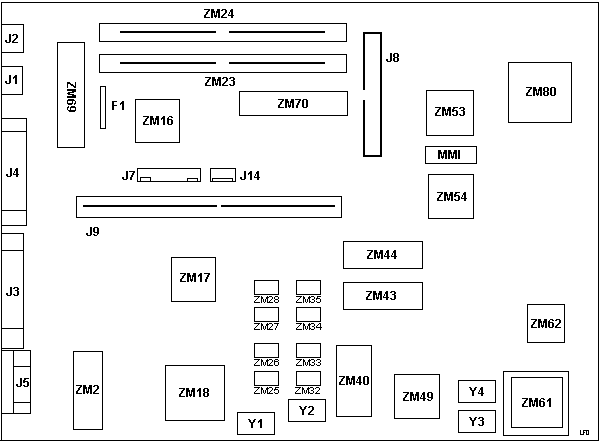
F1 3 A fuse
J1 Mouse port
J2 Keyboard port
J3 DB25 serial port
J4 Parallel port
J5 HDD15 video connector
J7 Power cable P7 header
J8 40-pin floppy header
J9 Bus Riser
J14 Power cable P14 header
ZM2 IMGS171S-35
ZM16 23F8566
ZM17 23F9177
ZM18 15F6864
ZM23,24 72-pin SIMM sockets
MMI 33F5102 hot glued to planar
|
ZM25-28, 32-35 NEC D4146L-10
ZM40 Dallas DS1287 RTC/CMOS
ZM43 33F8145 BIOS Odd
ZM44 33F8146 BIOS Even
ZM49 27F4620
ZM53 27F4659
ZM54 27F4619
ZM62 80386SX-16
ZM61 80387SX-16
ZM69 P8042AH
ZM70 NEC D765BC
ZM80 90X8134(ESD) DMA Controller
Y1 25.175 MHz osc
Y2 28.32200 MHz osc
Y3 14.31818 MHz osc
Y4 32.00000 MHz osc
|
Peter wrote (edited):
Early Model 55SX had a riser card connector with solder pins that
were too long. If you applied pressure to the top of the case, it would
propagate through the riser card to the planar, which would come in contact
with the grounded chassis - shorting some of the data bus signals. [snip] (IIRC
there was an ECA "IBM dealer confidential" on this topic)
The "dead cockroach" board with the many patch wires and the glued,
silver-capped patch chip. Needs the almost bare riser card, does not work with
the later ones (or not always). Had various problems from which the
non-functional pin to shut off the 386SX is the worst. Does not work with
"clip-on" processor expansions. Fails with 8514/A + network cards.
8555 System Board FRU P/Ns
27F4667 Model 031 AND 061 (55SX). Bus Adapter, 55SX FRU P/N 27F4666
57F3003 Model LT0 AND LE0 (55LS). Bus Adapter, 55LS FRU P/N 64F3732
33F8159 Model B00, C00, P00 (55SX MEDIALESS)
Later 8555SX Planar
SX: FRU P/N 27F4667 / 57F1536 / 57F1538
![27F4667 Front [P]](/other/img/photo.gif)
LS: FRU P/N 57F3003 / 84F6889
![57F3003 Front [P]](/other/img/photo.gif)
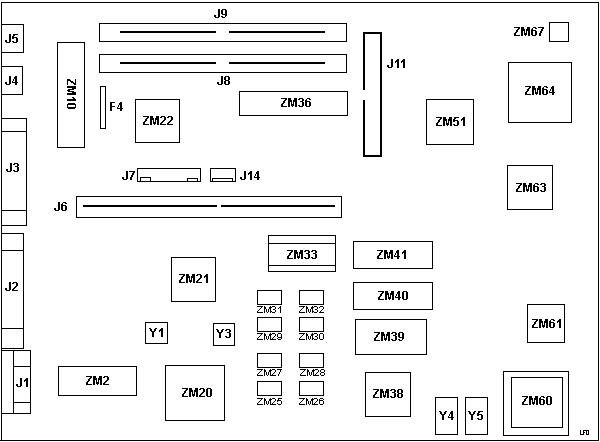
F4 Keyboard/mouse fuse
J1 HDD15 video connector
J2 DB25 serial port
J3 Parallel port
J4 Mouse port
J5 Keyboard port
J6 Bus Riser
J7 Power header P7
J8,9 72-pin SIMM sockets
J11 40-pin floppy header
J14 Power header P14
ZM2 inmos IMSG171P-35R
ZM10 P8042AH
ZM20 15F6864 or 90X8941 VGA
ZM21 37F0728 or 23F9177
ZM22 23F8566
ZM25-31 NEC D4146L-10
|
ZM33 Ext. NVRAM socket (55 LS)
ZM36 NEC D765BC
ZM38 27F4620
ZM39 Dallas DS1287 RTC/CMOS
ZM40 33F8145 BIOS Odd
ZM41 33F8146 BIOS Even
ZM51 57F1139
ZM60 80387SX-16
ZM61 80386SX-16
ZM63 27F4619
ZM64 90X8134(ESD) DMA Controller
ZM67 57F1505 PAL or pads only
Y1 28.3220 MHz osc
Y3 25.1750 MHz osc
Y4 32.00000 MHz osc
Y5 14.318181 MHz |
The revised 55SX board FRU P/N 27F4667. Components slightly rearranged.
Riser cards have more capacitors and / or the 74LSxx glue that fixes a problem
with 8514/A-style cards.
The 55LS "netcomputer" planar FRU P/N 57F3003 is derived from the 27F4667.
It uses the 74LSxx riserboard, different ROM, and has the 2K NVRAM populated
(-LEO/-LTO models).
> What is the unpopulated 24-pin DIP socket by the RTC? None of my
55 boards have it filled in. RIPL ROM if the network board didn't have it?
Peter says:
It is for a 2K CMOS RAM extension chip (6116 or something) that
adds to the one in the Dallas RTC - needed for some purpose on totally
medialess 55SXs (no FDD, no HD, only NIC). I think it is intended to hold some
system status / shutdown infos that are usually written to disk.
FRU P/N is 64F0722 "2KB NV RAM Module"
William Walsh:
Also has anybody ever seen the resisters soldered on top the
IMGS171S-35, it's labeled as ZM2 on Louis' page. On this machine they have
soldered 6 resistors in connecting some of the pins on that chip. I'm wondering
if this is a custom job or something IBM did??
It's something IBM did. I don't know what the exact purpose is, but it
circumvents problems that IBM experienced with the RAMDAC. Model 30-286 planars
may also have this fix.
David Beem:
They are diodes. Only present for some plastic versions of the
RAMDAC. The ceramic version was fine.
System Firmware (POST & BIOS)
Firmware stored in EPROM.
ROM Images
Model 55 SX
33F8146 / 33F8145 - 02 Nov 1988, rev. 0, 2x 27C512 (ZM41 / ZM40 or ZM44 / ZM43)
92F0626 / 92F0627 - same contents as above
33F8102 / 33F8103 - 07 Jan 1989, rev. 1, 2x 27C512 (ZM41 / ZM40 or ZM44 / ZM43)
Model 55 LS
84F6896 / 84F6897 - 08 Feb 1990, rev. 0, 2x 27C512 (ZM41 / ZM40)
requires later planar w/ extended NVRAM (ZM33) installed
Riser Cards
Early Riser P/N 27F4625 / 27F4630
![Front [P]](/other/img/photo.gif)
![Back [P]](/other/img/photo.gif)
![Front (alt) [P]](/other/img/photo.gif)
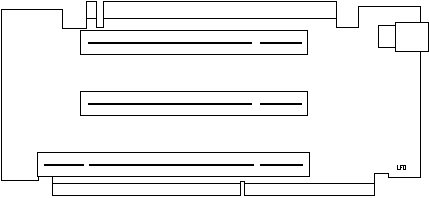
This riser is bare of anything to the right of the MCA
slots but the battery/speaker connector.
Newer Riser FRU 64F3732, P/N 27F4625, 64F0774
![Front [P]](/other/img/photo.gif)
![Back [P]](/other/img/photo.gif)
![Front (alt) [P]](/other/img/photo.gif)
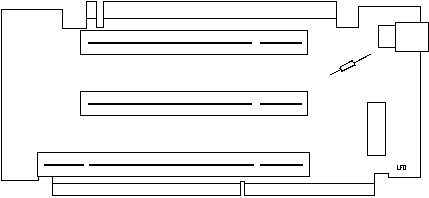
This riser has an addition of a resistor, a 74F08, and a bit of wiring on the back.
Late Riser FRU 27F4666, P/N 64F0808, 64F0809
![Front [P]](/other/img/photo.gif)
![Back [P]](/other/img/photo.gif)
![Front (alt) [P]](/other/img/photo.gif)
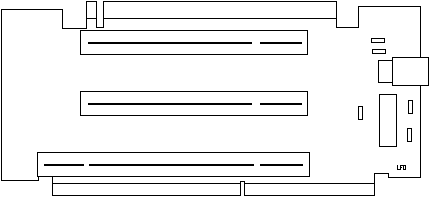
The battery/speaker header is moved down and a few resistors and capacitors are added.
The IC (ZM1) is still the same - 74F08.
64F0809 takes care of hangs with the 8514/A card.
Memory
Supports 1 MB and 2 MB 100 ns and 85 ns SIMMs.
Model 55 Tech Ref, 2nd Ed. claims 4 MB / 80 ns support.
[55SX -041 / -081, 55LS -LE0 / -LT0]
The PS/2 Models 55 SX and LS are compatible with:
DESCRIPTION FEATURE PART
SYSTEM BOARD MEMORY NUMBER NUMBER
PS/2 1 MB Memory Module Kit 85 ns 5212 6450603
PS/2 2 MB Memory Module Kit 85 ns 5213 6450604
PS/2 4 MB Memory Module Kit 80 ns 3933 87F9977
8555 -031 / -061
o 1 MB Memory Module Kit (85 ns) (#5212) (6450603)
o 2 MB Memory Module Kit (85 ns) (#5213) (6450604)
Type 2 Serial Port Controller
Some Type 2 serial controllers used on the Model 55 system board do not
respond as described in the Hardware Interface Technical Reference.
After the FIFO mode is enabled, bit 6 of the Interrupt Identification
register is erroneously set to 0, indicating a Type 1 serial controller is
installed. Any application program or operating system that uses bit 6 of the
Interrupt Identification register as an indicator to determine FIFO support
will default to the character mode. This indicator is ignored by the Model 55
ABIOS. Therefore, programs that operate through ABIOS can use the FIFO mode.
The ABIOS routines also clear any error indications remaining after a mode
change.
Some application programs reset the received-data-ready indication by
writing bit 0 of the Line Status register as a O. This method can cause
compatibility problems and is not supported by Type 1 or Type 2 serial
controllers. To avoid compatibility problems, bit 0 of the Line Status register
can be reset to 0 by reading the data and discarding the data if it is not
used.
The Model 55 supports FIFO through ABIOS calls only.
Type 1 Parallel Port Controller (?)
Bi-Directional, no DMA.
> No, it doesn't get to the menu. It just says that the battery is dead
then starts the Automatic Configuration (or, at least, attempts to). I tried
unplugging everything and the plugging them one by one, but without any luck.
It does the same thing every time...
Peter says:
Recently it may happen that the battery is *that* drained, that
the CMOS cannot be properly written and the next reboot reads corrupted data
and hangs the system.
After a power cycle and reboot from the reference
diskette the silly game repeats.
You will have to swap out the DS1287 chip for another one. If you cannot get
the 1287 you may use the DS12887, which is the pin- and function compatible
successor of the 1287.
CMOS Clear Method
Aron Eisenpress comes up with:
"I have exactly the same problem with a 55SX. Only in my case I was trying
to install OS/2 on it. The install progressed to the first reboot and then
couldn't boot off the drive. What's weird is that it manages to copy all the
files to the drive during the installation, so it does see the drive, it just
won't boot from it.
Aron suggested the following, but I haven't had a chance to try it yet. I
have to look for a DOS floppy to boot from. If you try this and it works please
post it here.
"I did some searching on the 55sx problem after replacing the Dallas RTC
chip, and found one suggestion that says you need to clear the CMOS before the
configuration will take.
The method is to boot from a floppy, run DEBUG, and type:
o 70 13
o 71 00
q
Then run the reference diskette and autoconfigure again.
Color Changes After Memory Upgrade
I keep losing half my color settings in Windows whenever I increase the ram
chips from 2 meg to four meg. Does anyone know what settings are being changed
(INI files, resolution)? Any tips welcomed.
Peter replies (edited):
I have seen this twice in the past that a Mod. 55SX "reacts funny"
on memory upgrade. In both cases it was a *board* failure: #1 had a micro-crack
in one copper-line at the underside of the board #2 had the pins of the
riser-card connector too long and these touch the grounded chassis after
re-insertion of the riser card. Both errors showed up only with 2 memory
modules installed. Pretty strange.
I would suggest to try out a "bread-board"
installation. Remove the board from the chassis, remove the power supply also
and place it on a non-conductive surface (Warning: underside pins may scratch
furniture). Install the memory modules, the riser board and lay HD and FDD in a
place where it can be connected but do not touch board or power-supply. When
the system runs fine without the chassis inspect the underside of the planar if
there are cracks or too long component pins, especially on the riser-card
connector and around all places, where the board fixing screws go.
And: there are some combinations of planars / riser-cards known as non
working. If the planar FRU is 27F4667 the appropriate riser-card must be
27F4666 (P/N 64F0809 on a white sticker, contains a 74F08-chip and some
capacitors / resistors. The almost totally empty riser-card (P/N 274630 on
white sticker / 6 capacitors between slots / 2 larger tinned areas at the rear)
belongs to an early down-level 55SX-planar and is known to cause problems. The
2nd series risercard.
LPT File Transfer Issues
William said:
I noticed that it will not establish a "InterLink" connection with
a model 70 via the parallel port...
My question: Is there a major wiring difference between the 55 and 70 ports?
I know my cable will work with two 70s...and that the 55 will print, so I
assume that the port must be OK.
I'm more curious than anything else now...I've since decided to just use two
model 70s to transfer the contents of one hard drive to the other.
Peter wrote (edited):
No - [they] are both the same layout. But some early Mod. 55SX
suffer on a sort of systemboard bug that changes the LPT timing a bit and they
choke on faster transmissions in bi-directional mode - like with using EPP
devices (CD-ROM, Iomega Zip drive) or Interlink. Those EPP devices run but
rather slow and if you connect that 55SX to another computer with LapLink you
will get a hell of time-out errors when copying larger files (until the system
hangs).
It is pretty hard to tell which boards are affected. I found out during
testings, that mainly those old boards tend to fail that have the "dead
cockroach" chip at the mid/front. It is sitting between the two bigger square
chips and is accompanied by a silver capped chip glued to the board. Both are
wired to the system with patch-wires. These machines have the old Level-1 riser
card 27F4630 (printed on a decal), which is almost bare apart from six small
capacitors between the MCA connectors. The Level-1 riser board has no chips and
no "component printing" in white. The board P/N is 33F5064 (sticker over
33F5060 P/N - which was the buggy, unfixed original board P/N).
There was a revised systemboard without the patch-on chip, which came with
the Level-2 riser (several resistors, some el-co's and the small capacitors -
came with an ECA from IBM due to problems running 8514/A style cards), which
has been replaced by the Level-3 riser 64F0809 with a 74F08 chip (ZM1). The
early 55SX planar cannot be used with the Level-3 risers ... the later
systemboard should not be used with the bare Level-1 riser.
The later sysboard is FRU P/N 27F4667, P/N 85F0419 (55SX) or 57F3003 (55LS /
LEO/LTO - which have the additional 2K CMOS NV-RAM), the riser is FRU P/N
27F4666, P/N 64F0809 (55SX) or 64F3732 (55LS). Sadly the FRU alone does not
tell, which P/N is behind ... IBM always delivered the latest P/N at a FRU
request.
I installed about 350 - 400 Mod. 55SX in the early '90s for the German
Automobile Club, so I guess I knew them quite well ... :-)
DBA Hard Drive (from Peter)
The harddisk is in fact a camouflaged MCA-adapter with a harddisk mechanism
atop.
The entire MCA bus is fed over the cable to the drive. This drive is the
fourth MCA slot, which shows up in the configuration. In case the contacts
between board and riser, riser and cable, cable and harddisk are oxydated -or-
in case the cable is slightly damaged there will be a communication problem
between board and harddisk - which in the end leads to 1048x HD-error or "hang
condition" during Power On Self Test (boot-up).
Planar Memory
The maximum system board memory capacity is 8MB (4MB memory module kits
installed in memory-module connector 1 and 2). A memory-module kit must be
installed in memory module connector 1. The system can support a total of 16 MB
of memory.
Aron Eisenpress:
My experience is that the 55SX is fine with one SIMM, but it must
go in the slot closer to the power supply. The 55SX takes PS/2 SIMMs, 1 MB, 2
MB, or 4 MB, either 85 ns or 100 ns. I'm pretty sure it can also take 80 ns
SIMMs (definitely can in the 4mb size), but I'm not certain.
486 CPU Upgrade (In)compatibility
>Any reason why the 486 upgrade for 56/57 it won't work on the 8555?
Peter replies:
Older 55SX had a slightly buggy mainboard / CPU where the "CPU
disable" pin did not work as supposed. You could use "clip-over" upgrades only
on the 55SX anyway since it has no "upgrade" socket of any sort (the 387SX
socket does not feed all required lines through ...).
If your 55SX planar has the "dead cockroach" fix (silver capped chip with
patchwires around) suspect it as one of the earlier ones that might or might
not work. The early models with the "bare" riser card without any TTL-logic
chip and without lots of capacitors had multiple troubles - not only with the
CPU.
>But could you ground out a pin directly on the CPU?
Peter replies:
As far as I recall IBM reported having got a quantity of 386SX
where the disable pin does not work *at all* - and therefore any clip-over
upgrades won't work.
The "dealer confidential" paper I have in mind mentioned the 55SX / 65SX
only - none of the other SX-machines (like L40, N33 etc.) where the case
forbids to use any updates anyways. The L40 however had been on the "CPU
upgradeable" list at Hantz & Partner (www.upgrade.de) years ago, which was
a "send-in upgrade" with soldering on board level. So it seems as if only very
early 16MHz 386SX were affected by this general fault.
The corresponding pin is -FLOAT ("FLT#", active low - pin 28), which "floats
all Intel 386SX bidirectional and output signals, including HDLA. Asserting
FLD# isolates the Intel 386SX from the surrounding circuitry." (Intel Datasheet
24018708.PDF, Page 60) Originally this pin was added to allow in-circuit
emulation without the need to unsolder / remove the chip from the board.
Simple test: ground pin 28 and the system may not POST. If it does the chip
is one of those faulty few.
Alfred Arnold:
386SX/16 CPUs in general do not have a (working) disable pin,
except they bear a 'C STEP' writing (most of the ones I've seen don't...). All
386SX CPUs with 20 MHz or more use at least the C stepping mask, so that's not
a issue for them...
Remove Password
To remove the password:
- open the cover (hardest part of the operation...)
- locate the speaker cable from the front to the vertical bus riser card
- unplug the cable at the bus riser card
- turn it around by 180 degrees
- plug it back to the bus riser card
- close the cover.
Password is gone.
Known Problems
305 ERROR CODE In The IBM PS2 Model 55SX
(from COMPUTERCRAFT)
This generally results from an easily replaced fuse on the motherboard,
right near the Keyboard and mouse connectors. The fuse is in a holder. No
soldering is required to remove it. The fuse is made by BEL FUSE - 5MF, 3 AMPS,
250 VOLTS [5MF(P) 3-R].
Radio Shack equivalent is part number 270-1054. It's also called a type GGS
5x20 mm fuse. An exact replacement from another source may be substituted.
This fuse often goes when a serial mouse is used with a PS2 adapter. Only
use a true PS2 style mouse in the 55SX. The keyboard or the mouse could also be
bad.
160 POST Error
A 160 POST error will be displayed if the Bus Adapter Card (FRU P/N 27F4666)
is not installed in an 8555.
If the Bus Adapter is removed for problem determination, or not re-installed
after replacing the system board, the system will not complete POST
successfully. The Bus Adapter Card is required by the 8555 for system
self-identification.
160 POST error may also be caused by a defective bus adapter.
168 POST ERROR ON 8555
If a 168 POST error code is displayed after replacing the system board in an
8555, verify that the correct system board is installed. If the correct system
board is installed, a 168 error usually represents a Token Ring adapter
problem.
The 8555 LAN SYSTEM BOARD P/N 33F8159 is intended for use in special bid
55SX MEDIALESS* Workstations. If installed in an 8555 MODEL 031 OR 061, the
machine will POST a 168 error and will not boot from drive A.
* Note: 8555 "MEDIALESS" Models may be upgraded
with diskette and fixed disk drive options. The model number should be used to
determine the correct system board FRU.
104XX ERRORS In a PS/2 55SX (Model 061 ONLY) (H035587)
If a 104XX error occurs in an 8555 Model 061, check for a power supply
barcode label K1DLXXXXXXX (X = any number). If the bar code matches, replace
the power supply (this power supply can also be identified by a plastic power
supply fan grille). If the power supply does not match the above description,
follow the normal problem determination procedure.
Important: This power supply should be replaced in
8555 Model 061's only.
201 POST Error On 8555 MEM Location (H063320)
If an 8555 displays a 201 POST error, verify that a SIMM has been installed
in the connector closest to the edge of the system board, next to the power
supply.
If the memory is installed correctly, and the error remains, follow FRU
isolation procedures in the hardware maintenance service pamphlet.
8555 System Board Damage And Related Handling (H021594)
Failure analysis of returned PS/2 8555 system boards has revealed that some
boards have physical damage to the phase lock loop (PLL) SIP component. The PLL
SIP is a small ceramic circuit board, mounted vertically on the system board.
It is approximately one inch wide and 3/4 inch tall, and is soldered to the
system board very close to the power supply cable connectors.
The reported damage is a result of the PLL SIP being bent at its system
board connectors. The PLL SIP is supposed to be mounted at a 90 degree angle to
the system board. Its design will permit some connector bending (up to a 20
degree angle from its intended perpendicular mount). Once bent, however, the
PLL SIP must not be straightened.
Important
On the replacement system board FRU, if the PLL SIP is bent toward the
power supply connector, and interferes with plugging in the power supply
cables, do not straighten the PLL SIP. Return the system board as new
defective. If bent away from the power supply connector, and if the system board
operates, the system board should be considered good. Do not straighten the PLL
SIP.
ADF Sections for @DF9Fh "Integrated Fixed Disk and Controller"
DMA Arbitration Level
DMA channel adapter uses to transfer data
< "Level 5">, 6, 7, 0, 1,
3, 4
DMA Burst Pacing Interval
Time interval between DMA transfer bursts
during which the Micro Channel is released by the fixed
disk controller for use by the CPU. Under normal
circumstances, select <24 Microseconds>
<"24 Microseconds">, 31,
16, Burst Disabled
DMA Pacing Control
Enables or disables the 'DMA Burst Pacing
Interval.' If set to <Burst Disabled>, the DMA
Pacing Control will be disabled. Under normal
circumstances, select <Disabled>.
<"Disabled>, Enabled
Time to Release
The amount of time that the fixed disk
controller will keep the Micro Channel after being
preempted. If the 'DMA Pacing Control' is set to
<Enabled>, the Time to Release will default to
immediate. Under normal circumstances, select <6
Microseconds>.
<"6 Microseconds">, 3,
Immediate
Fairness On/Off
Whether the adapter will release control of
the bus when it has been using it exclusively. Under
normal circumstances, select <On>.
<"On">, Off
Primary/Alternate Port Addresses
Port addresses used by the adapter.
Either <Primary> or <Alternate> will work
equally well. If there are two integrated
fixed disks, then select <Primary> for one and
<Alternate> for the other.
<"Primary">
(3510h-3517h), Alternate (3518h-351fh)
|